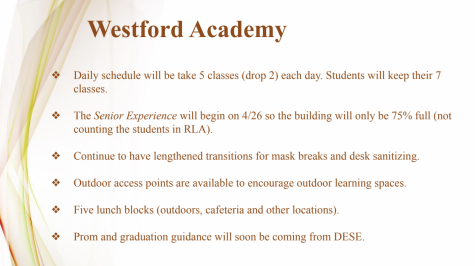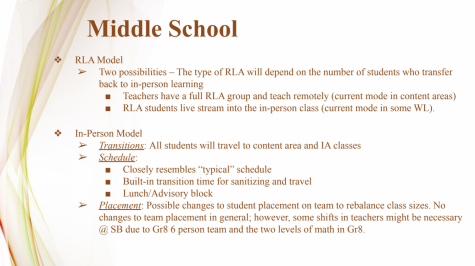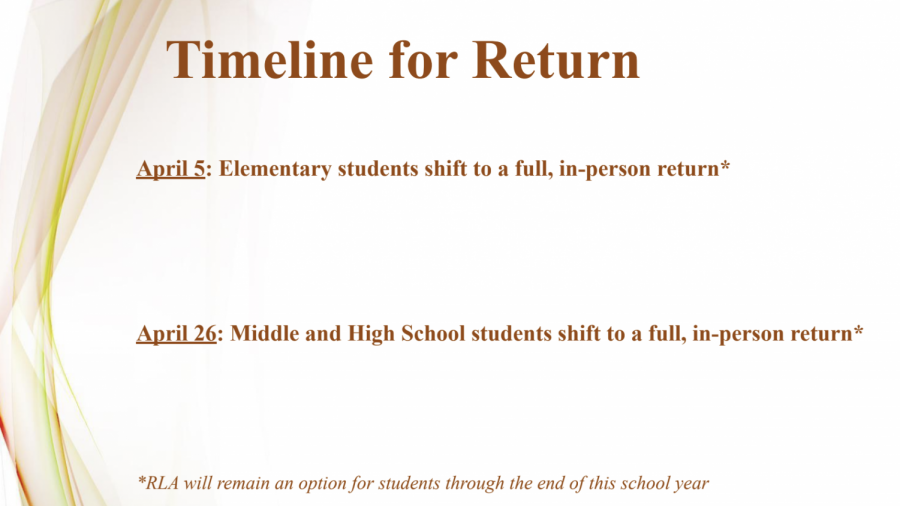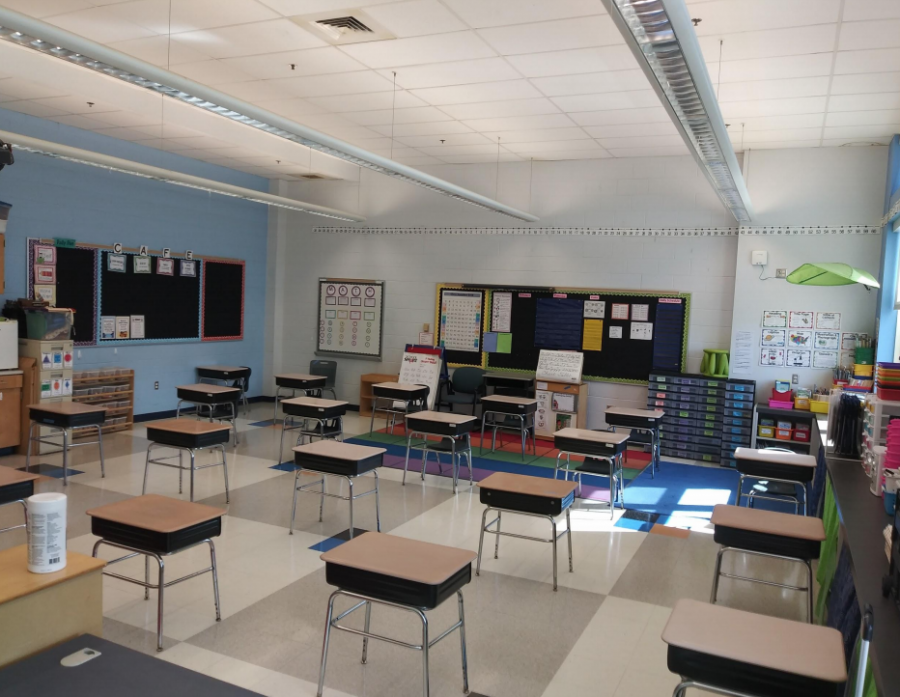WPS begins full reopening after state-wide mandate
March 17, 2021
After Massachusetts Commissioner of Education Jeff Riley’s state-wide directive for the reopening of all schools, the school committee unanimously voted in favor of an April 26 reopening for grades 6-12, following the mandated April 5 reopening of grades K-5. Westford Public Schools will transition from the current hybrid model to a full in-person return, with the Remote Learning Academy still in place as an option for families.
I. Logistics
In late February, Commissioner Riley issued the state-wide mandate for school re-openings and announced that remote and hybrid learning time would no longer count towards the structured learning time and that a full return to school would need to happen in all MA school districts.
One reason grades six through twelve schools will be reopening later than elementary schools is because WPS wanted to give Westford Academy and middle school faculty extra time to receive vaccinations.
However, vaccinations are not a prerequisite for returning back to school, and WPS will not be conducting pooled testing for students and staff. According to Clery, the cons of pooled testing outweigh its benefits.
“We have chosen not to do pool testing going forward if somebody tests positive. The contact tracing recordings for testing is time-consuming. It’s expensive, it’s disruptive, and nurses have numerously stated that they don’t think the process possesses the value that one might think,” Clery said.
In addition, according to Olsen, opening middle and high schools on April 5 as well would violate the memorandum of agreement between WPS and its faculty members. This would then necessitate a faculty vote in order to comply with a 45-day notice period to be given prior to schedule changes. By April 26, WA seniors will have also left for senior experience projects, allowing for better social distancing in schools.
Finally, pod A has had less in-person time than pod B, so waiting until April 26 will even out the difference between pod A and B in-person time.
Although Commissioner Riley mandated a middle school return for April 28, with no determined date for the high-school level, WPS feels April 26 is the optimal date to transition both WA and the middle schools together.
Based on a study conducted by the DESE that gathered data from schools in Massachusetts, there was no significant difference in the spread of COVID-19 between the three-feet distance and the six-feet distance. Thus, WPS Administration feels comfortable with a three-feet distance instead of a six-feet distance, with masks still required for all faculty and students.
In regards to in-school safety, assistant superintendent Kerry Clery and other administrators understand that the three-feet distance instead of the six-feet distance is a concern for parents and staff.
“We understand that there will be more close contact with the three-feet distance. Dr. Fauci mentioned that the three-feet distance seems to be okay for returning to school, and the CDC will be releasing new guidance… We want to [assure the community] that we have appropriate measures and rules in place to handle this closer contact,” Clery said.
All the current measures, including controlled hallway traffic, mandatory masks, and sanitization states, will be in place. However, the bus capacity limitations have been lifted. Students will still be required to wear a mask on buses, windows will be cracked by at least two inches, and there will be assigned seating.
On the topic of busing, families can purchase bus passes for $150 per student. Bus passes must be purchased three days before a student boards a WPS bus.
As for lunch periods, lunches will be grab-and-go, students will need to sit six-feet apart at the least in the cafeteria, and appropriate seating measures as well as lunchroom capacities will be put in place.
Like lunches, multiple aspects of the new in-person model are under deliberation and planning, such as outdoor classes and schedules. According to Clery, the administration is actively navigating the logistics to provide the safest model for an effective return.
“The teamwork that goes into shifting this cruise ship on a dime, while we do have some time to plan and prepare, there are so many logistics that go into the planning process. We are being very deliberate and thoughtful,” Clery said.
II. Westford Academy (9-12)
WA will be on a 5-drop-2 schedule for the full in-person return, meaning that students will have five classes a day with a rotational daily schedule. According to WA Principal James Antonelli, this decision was made to effectively transition from the current three-classes-a-day model, as well as to allow appropriate safety measures to be conducted.
As for passing times, there will be nine minutes in between classes, as compared to the current twelve minutes. Students will still follow the one-way directions in order to manage hallway traffic.
“We wanted to eliminate some of the gatherings that take place in the hallways, so we decreased the amount of time students have between classes. We will have traffic flow and signage to keep students moving. Also, students will be able to go outside the building and walk around to get a mask break,” Antonelli said.
The administration is also in the process of planning the lunch schedule for WA and will base the amount of lunch periods on the results of the family survey that closed on March 16, which gathered data on the number of students returning to school and the number of students doing RLA. As of right now, Antonelli foresees around 4-5 lunch periods for WA.

“We have ordered a tent for outside the cafeteria, so we have two levels of the cafeteria. We are going to be creative with the courtyard and outdoor seating with picnic tables,” Antonelli said.
The same quarantine measures from the current model will apply to the new full in-person model; if a student or staff member is infected with COVID-19, they will stream in from home, given that they feel up-to-it.
As for senior activities, Antonelli hopes that the administration can work through a plan to bring all seniors back to school on April 16, the seniors’ last day of school. All the other grade levels will attend their classes virtually.
“We want to have the opportunity to have our seniors come into the building and be together one last time. We want to give them the chance to see teachers, hand back materials, and just be together as a class,” Antonelli said. “We have a lot of activities coming up in the next couple of months and are excited to provide the seniors with some positive memories.”
Antonelli is still optimistic about prom and graduation. The current plan for prom has the event taking place at Kimball Farms, where appropriate safety measures will be in place. Graduation, as of right now, will look similar to the Class of 2020’s graduation, where students and staff are socially distanced and wearing masks. Antonelli hopes that parents and additional family members can attend the event.
As for AP Exams, Antonelli understands that not all seniors will be taking the exams this spring because of COVID-19. Although seniors are free to stop attending their classes, Antonelli encourages the seniors to remain in their AP classes.
Going forward, Antonelli and administration will be working on the schedule and further safety and educational measures in the coming weeks, in hopes of ensuring an effective transition for both RLA and hybrid students into this new model.
“We are very excited. There is a lot of movement around the school to get logistics prepared for the full return. We are up for it and excited to have students back at Westford Academy,” Antonelli said.
III. Middle Schools (6-8)
After April vacation, the middle school transition will follow suit. At this level, all students will adopt their pre-pandemic schedules. In addition to normal core classes, advisory, and lunch periods, students will be able to travel to all content areas and integrated arts classes, and schools will build in additional transition time to allow students and staff to take the necessary safety measures. However, lunches will switch from a three-tier system to a six-tier system to accommodate social distancing.

While students will remain in the teams they are currently in, with an expected influx of RLA students making the decision to make a full return, teachers may be switched amongst teams in order to accommodate. Teams that contained only RLA students may dismantle, and instead, these RLA students will live stream into in-person classes.
“While the initial information that we’re seeing indicates that there probably is going to be a very large shift from RLA to hybrid, this would mean that we might have to dismantle those full RLA sections. RLA students on those teams and have to live stream into in-person classes. [..] But, that is a possibility that we’re going to be looking at because our advisories can only fit so many students in them in the first place,” Stony Brook Principal Christopher Chew said.
IV. Elementary Schools (K-5)
As per Commissioner Riley’s mandate, all K-5 students will return to schools on April 5 either in-person or online.
Classroom logistics are to see significant changes upon reopening. There will be no extended day kindergarten, but rather a morning day kindergarten running daily from 9:05 A.M. -12:20 P.M. Subsequently, RLA teachers will work with TAs to develop a schedule for live instruction with breakout groups.
In addition, classroom locations may change as well for students in order to maintain three feet of social distancing, and Clery suggested the prospect that there may be cases when students must be placed with another teacher for the same reason.
“We want to make sure that we’re not overloading one class, so we want to make sure that we are balanced too. We really would like to start planning, and to reduce the stress of the teachers and the families to make sure that we make a smooth transition whether a student is going to stay with their current teacher or not,” Clery said.
In order to accommodate for experiences unique to the elementary level, schools will continue to allow activities such as recess and integrated arts with some modifications. Schools will allow all students to use the playground equipment with their classmates as long as children are all three feet apart, and integrated arts classes may be held inside home-based classrooms.
The structure of the school day may also be altered in order to maximize the extracurricular enrichment students can engage in. Some of these changes may include a change in student integrated arts, special education, intervention, and band & string schedules. Some learning technologies such as the Chromebook carts will also be disbanded for the time being, and instead, personal devices will be used in order to limit virus spread.
V. Westford Academy Opinions
Now that students will be able to transition into a more stable learning environment whilst complying with pandemic restrictions, WA students have mixed feelings about the feasibility of the new learning model.
While Olsen and Clery acknowledge how the reopening plan may not be ideal for all students and families and may seem abrupt, although modified, students have been engaging in consistent schooling for the entire 2020 to 2021 school year.
“I know that it’s been a lot longer than two months since we’ve been in a normal team, but we have to keep in mind this fall has not closed school. Students have been coming to school either virtually or in person, just the group sizes significantly different, but we will be sure that teachers spend the time to connect with students [when reopening] and make sure that students feel comfortable in their class alignment connecting with your peers and re-establishing routines,” Clery said.
In line with Commissioner of Education Jeff Riley’s and Superintendent Bill Olsen’s goal of creating normalcy, some students such as Student School Committee Representative Hannah Macey believe as though this new model may be essential in bolstering collaboration between staff and students that is an integral part of the normal WPS school system.
“I think the reopening could benefit students in the sense that we’ll be surrounded by all our peers again and it will be great for collaborative work and engaging the class,” Macey said.
However, Macey also feels that a full return may be a culture shock, after having spent a year in either complete online or hybrid learning.
“I think in addition to all the pros of finally heading back to normalcy, we have to be aware of how big of a culture shock this is to all of us. I think with the full return so abrupt, it’s going to bring a lot of stress which will hopefully be addressed by teachers and administration. it’s also understandable that some teachers and students are not comfortable with the three feet of spacing when we’re going to be having up to twenty-five kids in a room after being in classes of ten,” Macey said.
As another facet to this, some believe as though a full reopening in a few months may be detrimental to the mental health of some individuals. After having been accustomed to a model that gives students more free time and more time to engage with teachers daily, some like junior Liam Neary believe that an April reopening may be counterproductive to the effects it plans to have– helping students get back on track with an optimal learning experience.
“I think the school reopening, while important to students’ education, is a massive risk for the mental health of high school students. I do not struggle with any mental illnesses, yet the current system is already hard for me, and the only thing keeping me sane is the extra free time. I am friends with people who face a variety of struggles, and I firmly believe this new structure this early poses a massive threat to them. The last thing we should be doing is adding more stress onto students when you can’t even go outside without being reminded of the state of the world,” Neary said.
In order to mitigate any negative effects reopening could have on mental health, the district plans on keeping the social and emotional support of students a focus.
For example, WA will be adopting a new block schedule with five classes per day model; as opposed to the six-class model in normal years, students will be eased into the change. Coupled with scheduling efforts to ease students into normalcy, committee chair Gloria Miller and Assistant Superintendent Clery stressed the importance of supporting students socially and emotionally in order to create a more comfortable learning environment. Before the re-openings, Clery will be meeting with a social and emotional health committee in order to make tangible plans to do so.
“We’d like to have an opportunity for students to have a little bit more relaxation, and an introduction to school, as we know that some of them are going to be nervous. We’re all going to be nervous, as it has been such a departure from the norm of us. So we’ll come up with some specific ideas,” Clery said.
Ultimately, the district plans to inculcate knowledge of the pros and cons of the current hybrid model to best adapt to an efficient reopening that is supportive of the community and its students.
“One benefit is that students have been working together in each one of the pods, and so yes there might be some changes. But in smaller groups, our teachers had gotten to know each other very well together. So, that’s another piece of it that I think helps with this transition is that our teachers are cognizant of [small group connections],” Chew said.
While it may be difficult especially in the initial stages, the community acknowledges that a reopening is a necessary next step to usher Westford students and families into a normal and optimal learning environment.
“I think safety and good learning can be achieved, but it may just be something we have to work a little harder,” Macey said.

